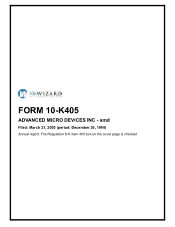AMD 1999 Annual Report Download - page 10
Download and view the complete annual report
Please find page 10 of the 1999 AMD annual report below. You can navigate through the pages in the report by either clicking on the pages listed below, or by using the keyword search tool below to find specific information within the annual report.strength and dominant position. Given Intel's industry dominance and brand
strength, Intel's processor marketing and pricing can impact and have impacted
the average selling prices of AMD-K6 and AMD Athlon microprocessors, and
consequently, can impact and has impacted our overall margins. As an extension
of its dominant microprocessor market share, Intel also dominates the PC
platform. As a result, it is difficult for PC manufacturers to innovate and
differentiate their product offerings. We do not have the financial resources
to compete with Intel on such a large scale.
As Intel expanded its dominance over the entirety of the PC system platform,
many PC original equipment manufacturers (OEMs) reduced their system
development expenditures and now purchase microprocessors in conjunction with
core logic chipsets or in assembled motherboards from Intel. PC OEMs are
increasingly dependent on Intel, less innovative on their own and, to a large
extent, distributors of Intel technology. In marketing our microprocessors to
these OEMs and dealers, we depend upon companies other than Intel for the
design and manufacture of chipsets, motherboards, basic input/output system
(BIOS) software and other components. In recent years, many of these third-
party designers and manufacturers have lost significant market share to Intel.
In addition, these companies produce chipsets, motherboards, BIOS software and
other components to support each new generation of Intel's microprocessors
only if Intel makes information about its products available to them in time
to address market opportunities. Delay in the availability of such information
makes, and will continue to make, it increasingly difficult for these third
parties to retain or regain market share. To compete with Intel in this market
in the future, we intend to continue to form closer relationships with third-
party designers and manufacturers of chipsets, motherboards, BIOS software and
other components. Similarly, we intend to expand our chipset and system design
capabilities, and to offer OEMs licensed system designs incorporating our
processors and companion products. We cannot be certain, however, that our
efforts will be successful.
Embedded Processors. Embedded processors are general purpose devices, which
consist of an instruction control unit and an arithmetic and logic unit, and
are used to carry out a single application with limited user interface and
programmability. We also offer a line of C186, C188 and AMD-K6E processors for
use as embedded processors in hard disk drives. We offer an expanding range of
embedded processors based upon x86 microprocessor technology for both
communications as well as handheld computing applications. These embedded
processors are derivative of the microprocessors we sell in PCs.
Memory Group
Memory Group products ($773 million, or 27 percent, of our 1999 net sales)
include Flash memory devices and EPROMs.
Flash Memory Devices. Our Flash memory devices are used in cellular
telephones, networking equipment and other applications that require memory to
be non-volatile and rewritten. These Flash memory devices may be electrically
rewritten. This feature provides greater flexibility and ease of use than
EPROMs and other similar integrated circuits that cannot be electrically
rewritten. Flash memory devices have a size and cost advantage over EEPROM
devices. Communications companies use Flash memory devices in cellular
telephones and related equipment to enable users to add and modify frequently
called numbers and to allow manufacturers to preprogram firmware and other
information. In networking applications, Flash memory devices are used in
hubs, switches and routers to enable systems to store firmware and
reprogrammed Internet addresses and other routing information. Use of Flash
memory devices is proliferating into a variety of other applications, such as
set-top boxes and automotive control systems.
Competition in the market for Flash memory devices is increasing as existing
manufacturers introduce competitive products and industry-wide production
capacity increases, and as Intel continues to aggressively price its Flash
memory products. In 1999, almost all of our Flash memory devices were produced
in Aizu-Wakamatsu, Japan through Fujitsu AMD Semiconductor Limited (FASL), our
joint venture with Fujitsu Limited.
6
Source: ADVANCED MICRO DEVIC, 10-K405, March 21, 2000























